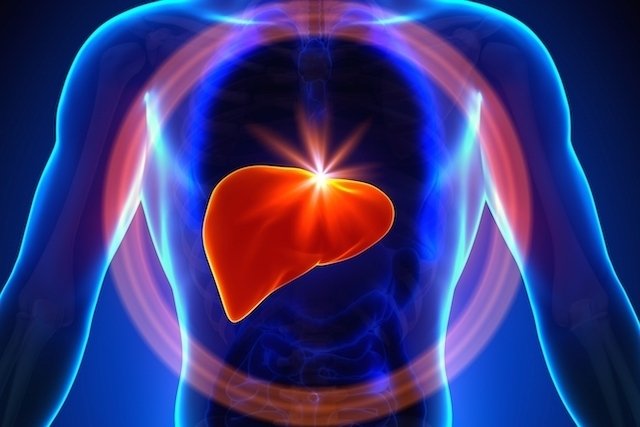Autoimmune hepatitis is an inflammation of the liver that occurs due to changes in the immune system. In these cases, the immune system starts to recognize its own liver cells as foreign and attacks them, causing a decrease in the functioning of the organ and leading to the appearance of symptoms such as abdominal pain, yellowish skin and severe nausea.
Autoimmune hepatitis generally appears before the age of 30 and is more common in women. Although there is no cure, autoimmune hepatitis can be controlled with appropriate treatment, which involves medications to control immunity, in addition to recommending a balanced diet, and avoiding the consumption of alcohol, fats and excess preservatives.
It is important that the treatment of autoimmune hepatitis is carried out according to the guidance of the hepatologist or general practitioner, as this makes it possible to avoid the development of fulminant hepatitis and organ failure.

Symptoms of autoimmune hepatitis
The main symptoms of autoimmune hepatitis are:
- Excessive tiredness;
- Loss of appetite;
- Muscle pain;
- Constant abdominal pain;
- Nausea and vomiting;
- Yellow skin and eyes, also called jaundice;
- Mild itching on the body;
- Joint pain;
- Swollen belly.
Typically, the disease has a gradual onset, progressing slowly over weeks to months until it leads to liver fibrosis and loss of function if the disease is not identified and treated. However, in some cases, the disease can worsen quickly and is called fulminant hepatitis, which is extremely serious and can result in death. See more about fulminant hepatitis.
Furthermore, in a small proportion of cases, the disease may not cause symptoms, being discovered in routine exams, which show an increase in liver enzymes. It is important that the diagnosis is made early so that treatment can be immediately established by the doctor, which can prevent complications such as cirrhosis, ascites and hepatic encephalopathy.
Autoimmune hepatitis in pregnancy
The symptoms of autoimmune hepatitis during pregnancy are the same as those of the disease outside this period and it is important that the woman is monitored by an obstetrician to check that there are no risks to both her and the baby, which is rare when the disease still exists. in the initial phase.
In pregnant women who have the disease more developed and have cirrhosis as a complication, monitoring becomes more important, since there is a greater risk of premature birth, low birth weight and the need for a cesarean section. Therefore, it is important that the obstetrician recommends the best treatment, which is usually done with a corticosteroid, such as Prednisone.
How the diagnosis is made
The diagnosis of autoimmune hepatitis is made through the evaluation of the signs and symptoms presented by the person and the results of laboratory tests that must be requested by the doctor. One of the tests that confirms the diagnosis of autoimmune hepatitis is a liver biopsy, in which a fragment of this organ is collected and sent to the laboratory to observe changes in the tissue that are indicative of autoimmune hepatitis.
In addition, the doctor may request the measurement of liver enzymes, such as TGO, TGP and alkaline phosphatase, in addition to the measurement of immunoglobulins, antibodies and serology for hepatitis A, B and C viruses. Find out more about the tests that evaluate the liver .
The person’s lifestyle habits are also taken into account at the time of diagnosis, such as excessive alcohol consumption and use of medications that are toxic to the liver, making it possible to exclude other causes of liver problems.
Types of autoimmune hepatitis
According to the results of antibody tests, autoimmune hepatitis can be classified into some main groups, such as:
- Type 1 autoimmune hepatitis: more common between 16 and 30 years of age, being characterized by the presence of ANA and AML antibodies in the blood test, and may be associated with the emergence of other autoimmune diseases, such as thyroiditis, celiac disease, synovitis and ulcerative colitis;
- Type 2 autoimmune hepatitis: it normally appears in children aged between 2 and 14 years, the characteristic antibody is Anti-LKM1, and can appear in conjunction with type 1 diabetes, vitiligo and autoimmune thyroiditis;
-
Type 3 autoimmune hepatitis: similar to type 1 autoimmune hepatitis, with positive anti-SLA/LP antibody, but possibly more severe than type 1.
Identifying the type of hepatitis is important so that the best treatment can be indicated with the aim of relieving symptoms, reducing liver inflammation and preventing the progression of the disease.
How the treatment is carried out
Treatment for autoimmune hepatitis is indicated by a hepatologist, general practitioner or gastroenterologist, and is started with the use of corticosteroids, such as Prednisone, or immunosuppressants, such as Azathioprine, which reduce acute inflammation of the liver, keeping it under control throughout the years. years, and can be done at home. In some cases, especially in young patients, the use of a combination of Prednisone and Azathioprine may be recommended to reduce side effects.
In more serious cases, where it is not possible to control inflammation with the use of medication, liver transplant surgery may be performed, which involves replacing the diseased liver with a healthy one. After liver transplantation, the patient must remain hospitalized for 1 to 2 weeks to ensure that there is no rejection of the new organ. In addition, transplant individuals must also take immunosuppressants throughout their lives to prevent the body from rejecting the new liver. See more about liver transplantation.
However, as autoimmune hepatitis is related to the immune system and not the liver, after transplantation it is possible for the disease to develop again.
How should the diet be
The diet for autoimmune hepatitis should be light and low in fatty and processed foods, as they can promote inflammation of the liver, hinder its functioning and promote the worsening of the disease. Thus, some foods that can be consumed in hepatitis are:
- Lettuce, tomato, broccoli, carrot, zucchini, arugula;
- Apple, pear, banana, mango, watermelon, melon;
- Beans, broad beans, lentils, peas, chickpeas;
- Seed bread, pasta and brown rice;
- Chicken, turkey or rabbit meat;
- Sole, swordfish, halibut.
It is important to give preference to organic foods because the pesticides present in some foods also make it difficult for the liver to function. Furthermore, it is recommended to avoid alcoholic beverages, fried foods, sausages, sauces, butter, cream and processed foods. Learn more about the hepatitis diet.
See more details about nutrition for hepatitis in the following video:

Sign up for our newsletter and stay up to date with exclusive news
that can transform your routine!
Warning: Undefined array key "title" in /home/storelat/public_html/wp-content/plugins/link-whisper-premium/templates/frontend/related-posts.php on line 12
Warning: Undefined array key "title_tag" in /home/storelat/public_html/wp-content/plugins/link-whisper-premium/templates/frontend/related-posts.php on line 13



